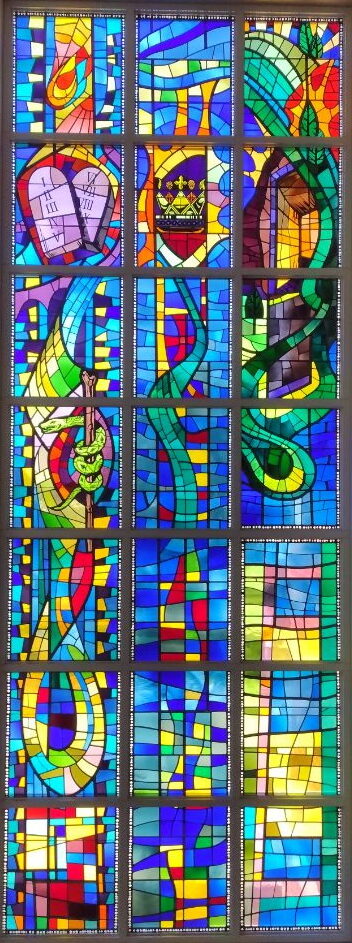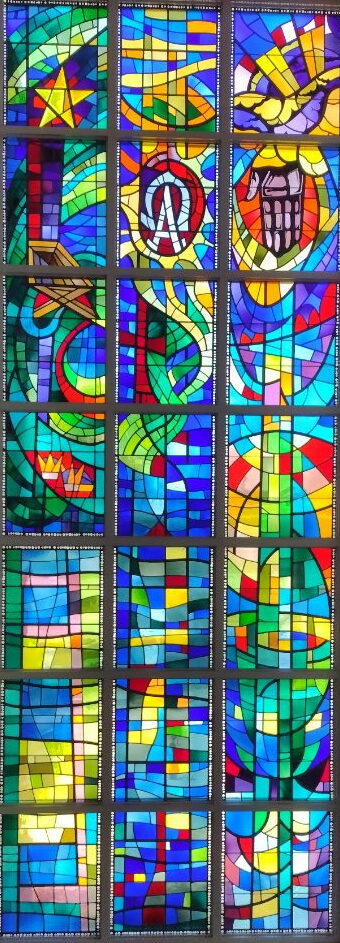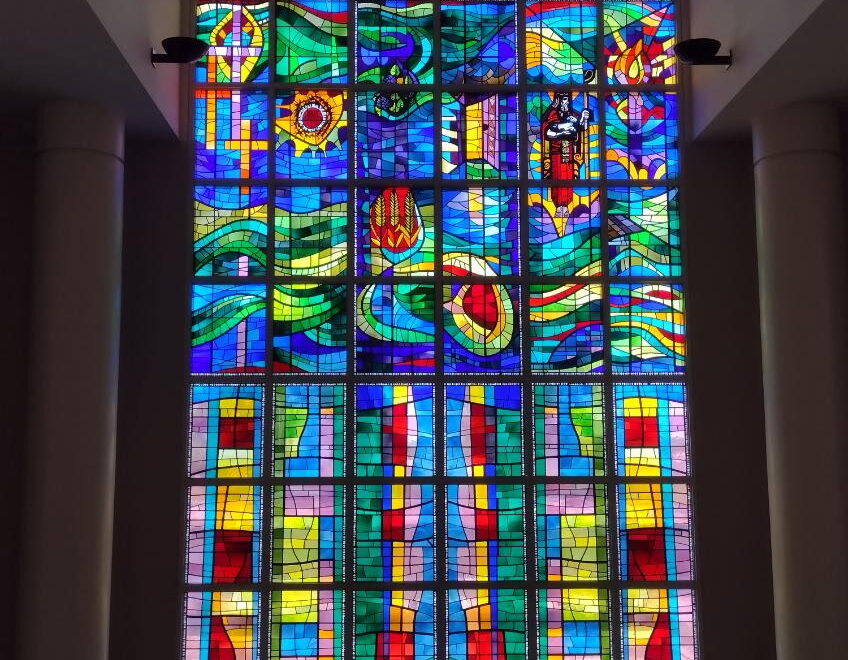
By Michelle Williams |
 In this edition of Let’s Visit Raytown, we are going to take a closer look at a landmark in Raytown most of us probably pass by at least once a week, if not every day. There is an element of this landmark that makes it especially relevant for those looking for unique tourist destinations. The landmark is Connection Point Church (formerly First Baptist Church of Raytown and the element is the beautifully handcrafted stained glass windows visible from the outside of the church.
In this edition of Let’s Visit Raytown, we are going to take a closer look at a landmark in Raytown most of us probably pass by at least once a week, if not every day. There is an element of this landmark that makes it especially relevant for those looking for unique tourist destinations. The landmark is Connection Point Church (formerly First Baptist Church of Raytown and the element is the beautifully handcrafted stained glass windows visible from the outside of the church.
Stained glass windows in churches are more than decoration and religious art; they serve as a means of telling Biblical stories. In fact, the use of colored glass can be found in the 7th century, with more significant usage and development in the Middle Ages. Stained glass windows in churches were utilized for centuries to teach those who were unable to read, or had no access to published Bibles. The stained glass windows also serve as a unique part of a local church’s identity, becoming true beacons of light within their communities.
Such are the stained glass windows of Connection Point Church. As I began research for this article, I did not realize while the stories behind the various windows were well documented, the history of the window’s design and fabrication was not. Enlisting assistance from local stained glass organizations, and a former stained glass company employee, I was able to piece together the history of these beautiful works of art which testify to the greatness of God.
First Baptist Church of Raytown had many names and locations prior to them building on Blue Ridge Boulevard in 1950.
 It would be this building that Luther and Ann Robinson would donate the stained glass windows we are discussing in this article. (There are other stained glass windows within Connection Point Church, however, they are not viewable from outside the church.) The stained glass windows from 1950 were fabricated by Hopcroft Glass Company, located at that time in the bottoms west of Swope Park off of 63rd Street in Kansas City, Missouri. The company began operations in the early 1900s but was closed when the third-generation owner passed away.
It would be this building that Luther and Ann Robinson would donate the stained glass windows we are discussing in this article. (There are other stained glass windows within Connection Point Church, however, they are not viewable from outside the church.) The stained glass windows from 1950 were fabricated by Hopcroft Glass Company, located at that time in the bottoms west of Swope Park off of 63rd Street in Kansas City, Missouri. The company began operations in the early 1900s but was closed when the third-generation owner passed away.
1It would be Hopcroft Glass Company¹ who was tasked with moving the stained glass windows from the Blue Ridge Boulevard location to the current location at 10500 East 350 Highway. The windows had to be resized to fit their new home in the front lobby and stairwells of the new church building; you can see where the windows were lengthened with additional stained glass since the original panels were too short for the new location. The windows themselves illustrate doctrines and depict the Life of Christ. The windows illustrating doctrine include: symbols of the Trinity; the symbol of God’s creative hand; the two covenants: the Scroll represents the Old
Testament or Old Covenant, and the open Bible represents the New Testament or New Covenant; symbols of salvation, with tablets representing the law and serpent illustrating the prophecy of the crucified Christ; and the symbols of security, including the ark representing God’s grace and a dove suggesting the coming of the Messiah.
 The windows depicting the Life of Christ include: The Nativity, with the star, the manger, and the crown, representing the birth of the King of kings; illustrations Christ gave of Himself, featuring a candle (“I am the Light of the World”); the Good Shepherd; illustration of Christ saying “I am the Door”; and symbols of the vine and the sheaves illustrating Christ as the “Vine” and “Bread of Life”. The window of the crown of thorns depicts Christ’s suffering. There is also a window with three crosses depicting Calvary and, finally, the open tomb, representing the Risen Lord and the promise of eternal life.
The windows depicting the Life of Christ include: The Nativity, with the star, the manger, and the crown, representing the birth of the King of kings; illustrations Christ gave of Himself, featuring a candle (“I am the Light of the World”); the Good Shepherd; illustration of Christ saying “I am the Door”; and symbols of the vine and the sheaves illustrating Christ as the “Vine” and “Bread of Life”. The window of the crown of thorns depicts Christ’s suffering. There is also a window with three crosses depicting Calvary and, finally, the open tomb, representing the Risen Lord and the promise of eternal life.
I was not going to include the descriptions of the windows; I felt it necessary not only to provide a guide to what you would see when you visit the site, but to also illustrate the artistry within the stained glass. It isn’t only beautiful, it tells a story, and each artist who worked to design and make each pane come to life was doing so without recognition of their work, as stained glass art is rarely signed and has few makers marks.
So, as you drive by on your commute, or while doing errands, consider taking a moment to drive into the Connection Point Church parking lot and look at the stained glass windows. You can’t miss them; they are under the steeple above the front doors. Let us know you visited by posting to our Visit Raytown Facebook page or use the hashtag #VisitRaytown!

